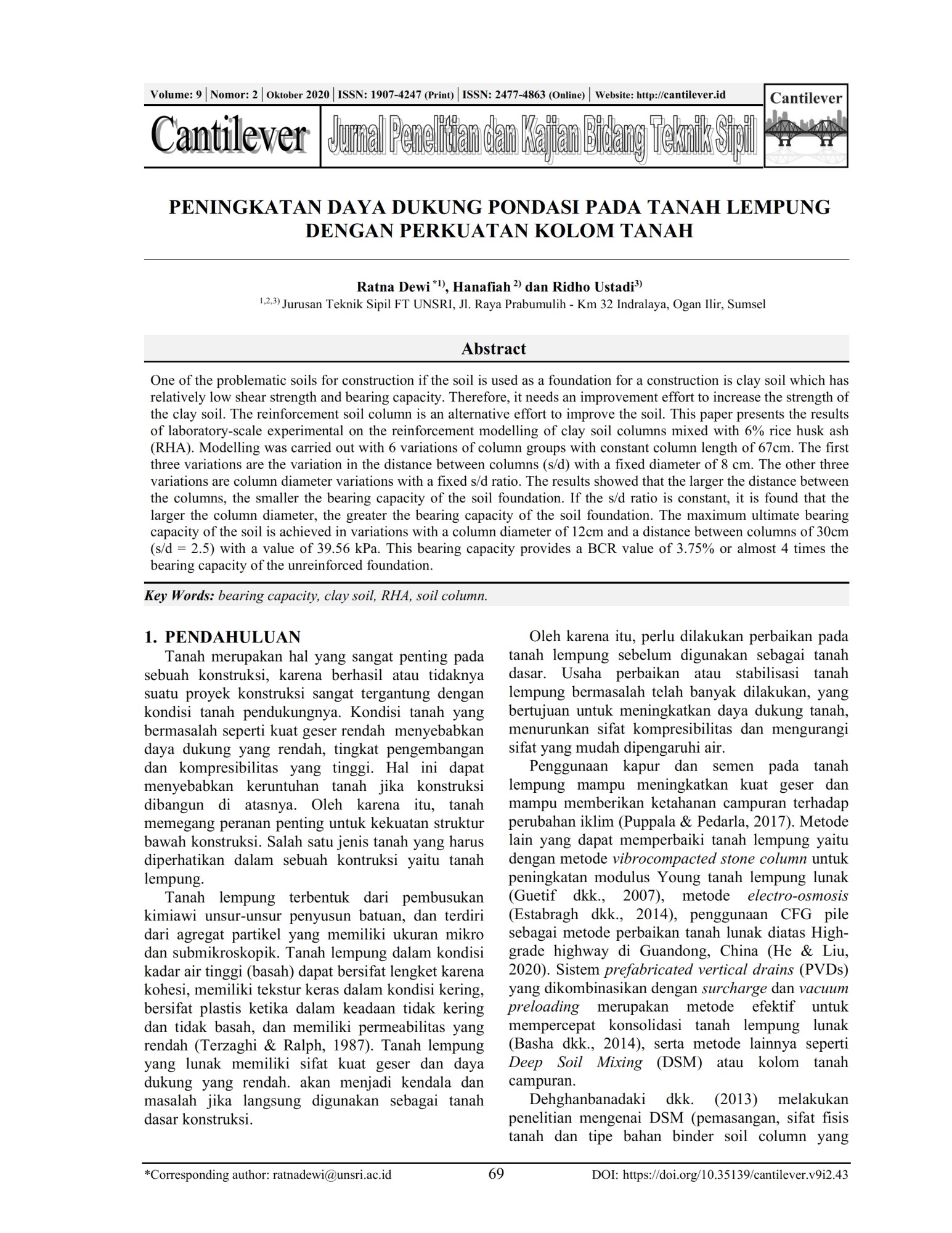Peningkatan Daya Dukung Pondasi pada Tanah Lempung dengan Perkuatan Kolom Tanah Improvement of Foundation Bearing Capacity in Clay Soil with Soil Column Reinforcement
Main Article Content
Abstract
One of the problematic soils for construction if the soil is used as a foundation for a construction is clay soil which has relatively low shear strength and bearing capacity. Therefore, it needs an improvement effort to increase the strength of the clay soil. The reinforcement soil column is an alternative effort to improve the soil. This paper presents the results of laboratory-scale experimental on the reinforcement modelling of clay soil columns mixed with 6% rice husk ash (RHA). Modelling was carried out with 6 variations of column groups with constant column length of 67cm. The first three variations are the variation in the distance between columns (s/d) with a fixed diameter of 8 cm. The other three variations are column diameter variations with a fixed s/d ratio. The results showed that the larger the distance between the columns, the smaller the bearing capacity of the soil foundation. If the s/d ratio is constant, it is found that the larger the column diameter, the greater the bearing capacity of the soil foundation. The maximum ultimate bearing capacity of the soil is achieved in variations with a column diameter of 12cm and a distance between columns of 30cm (s/d = 2.5) with a value of 39.56 kPa. This bearing capacity provides a BCR value of 3.75% or almost 4 times the bearing capacity of the unreinforced foundation.
Downloads
Article Details
Basha, A., Sakr, M. A., & Nimr, A. AL. (2014). An Experimental Study for The Effect of Vacuum Preloading on Soft Soil Improvement. The Eightth Alexandria International Conference On Structural And Geotechnical Engineering (Aicsge8), Alexandria, 14-16 Aptil 2014.
Dehghanbanadaki, A., Ahmad, K., Ali, N., Khari, M., Alimohammadi, P., & Latifi, N. (2013). Stabilization of Soft Soils with Deep Mixed Soil Columns - General Perspective. Electronic Journal Of Geotechnical Engineering, 18, 295-306.
Dewi, R., Borgan, W., Zunita, I., Yulindasari, & Iqbal, M. M. (2019). Effect of Deep Soil Mixing to Increasing Bearing Capacity on Peat Soil. International Journal Of GEOMATE, 17(63), 126–132.
Esmaeil, M., Khajehei, H., & Astaraki, F. (2017). The Effectiveness of Deep Soil Mixing on Enhanced Bearing Capacity and Reduction of Settlement on Loose Sandy Soils. International Journal Of Railway Research, 4(2), 33–39.
Estabragh, A. R., Naseh, M., & Javadi, A. A. (2014). Improvement of Clay Soil by Electro-Osmosis Technique. Applied Clay Science, 95, 32-36.
Guetif, Z., Bouassida, M., & Debats, J. M. (2007). Improved Soft Clay Characteristics due to Stone Column Installation. Computers and Geotechnics, 34(2),104-111.
He, L. & Liu, H. (2020). Effect Analysis of Different Treatment Methods for Soft Soil Foundation of Highway. Global Journal of Engineering Sciences. https://doi.org/10.33552/GJES.2020.06.000629
Oktavia, D. L., Dewi, R., Saloma, S. Y., Hadinata, F., & Yulindasari, Y. (2019). The Effects of Rice Husk Ash Substitution on Physical and Mechanical Properties of Clay. International Journal of Scientific and Technology Research, 8(7), 465-470.
Puppala, A. J. & Pedarla, A. (2017). Innovative Ground Improvement Techniques for Expansive Soils. Innov. Infrastruct. Solut. 2, 24. https://doi.org/10.1007/s41062-017-0079-2.
Terzaghi, K. & Ralph, P. B. (1987). Mekanika Tanah dalam Praktek Rekayasa. Jakarta: Penerbit Erlangga.
Zaika, Y. & Rachmansyah, A. (2017). The Estimation of Bearing Capacity and Swell Potential of Deep Soil Mixing on Expansive Soil by Small Scale Model Test. International Journal of GEOMATE, 13(38), 9–15.

This work is licensed under a Creative Commons Attribution-NonCommercial 4.0 International License.
Authors who publish with this journal agree to the following terms:
- Authors retain copyright and grant the journal right of first publication with the work simultaneously licensed under a Creative Commons Attribution-NonCommercial 4.0 International License that allows others to share the work with an acknowledgment of the work's authorship and initial publication in this journal.
- Authors are able to enter into separate, additional contractual arrangements for the non-exclusive distribution of the journal's published version of the work (e.g., post it to an institutional repository or publish it in a book), with an acknowledgment of its initial publication in this journal.
- Authors are permitted and encouraged to post their work online (e.g., in institutional repositories or on their website) prior to and during the submission process, as it can lead to productive exchanges, as well as earlier and greater citation of published work (See The Effect of Open Access).
